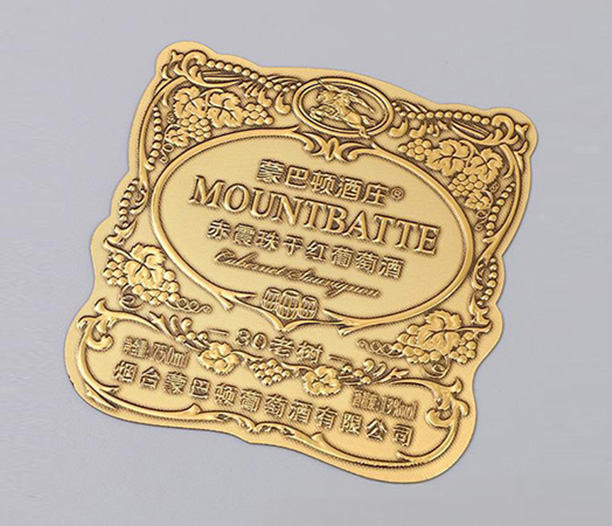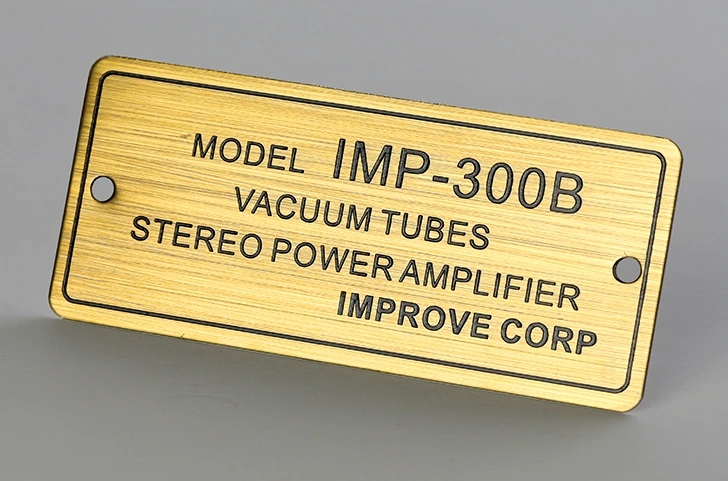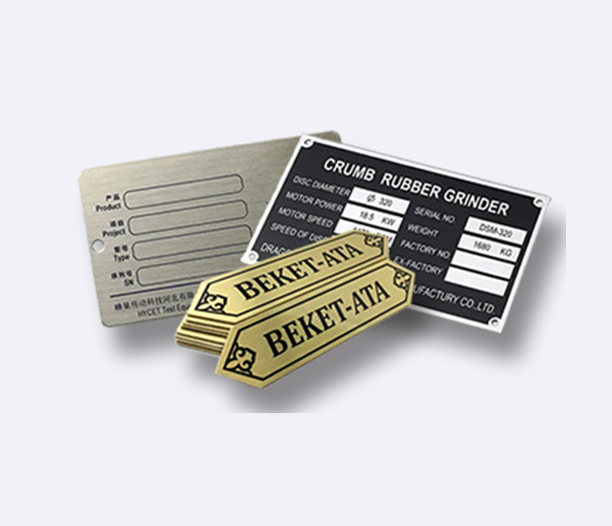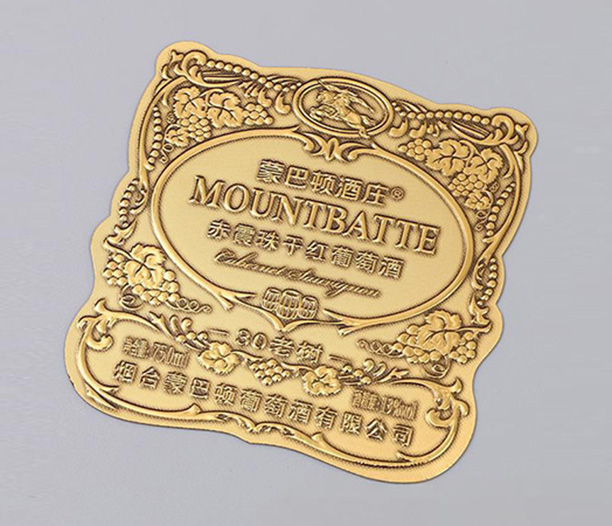So, you're thinking about using brass nameplates for your office doors, equipment, awards, or maybe even that classic mailbox. They look sharp, professional, and scream quality. But a big question pops up: "Will these beautiful brass nameplates fade over time and lose their luster?" It's a legit concern, especially when you're investing in something meant to last. Let's break it down, American style.
Here's the Deal: Brass Doesn't "Fade" Like Paint, But It Definitely Changes.
First things first, let's get our terms straight. When people ask if brass nameplates "fade," they're usually worried about them losing their bright, shiny, gold-like appearance. Pure brass itself doesn't fade in the way paint chips or colors bleach in the sun. Instead, brass undergoes chemical reactions that alter its surface look. The good news? This change is often manageable, sometimes even desirable! The key is understanding what actually happens and how you can control it (or not).

Why Your Shiny New Brass Nameplate Might Not Stay "New" Looking Forever: The Main Culprits
- Tarnishing: The Biggest Player (Hello, Patina!):What Happens: This is the superstar of brass transformation. Brass is an alloy, mostly copper and zinc. When exposed to oxygen and moisture in the air (humidity!), and especially to sulfur compounds (found in pollution, some paints, rubber, even egg yolks!), a chemical reaction occurs on the surface. This forms a layer called tarnish. Initially, it might look dull or slightly yellowish. Over a long time, especially outdoors, it can develop that iconic greenish-blue layer known as a patina (think Statue of Liberty).Does it Fade? Not fading, changing. The bright gold shine diminishes, replaced by darker, warmer, or eventually green hues. For many, this patina is a sign of character and age, highly valued in architectural and historical contexts. For others wanting that "like new" shine, it's the enemy.Speed: Tarnishing speed depends hugely on the environment. Coastal areas (salt air), industrial zones (pollution), or humid climates accelerate it. Indoor brass nameplates in climate-controlled spaces tarnish much slower.
- Lacquer or Clear Coat Failure: The Protective Shield Breaks:What Happens: Most commercially available brass nameplates designed to stay bright come with a protective clear lacquer or coating applied at the factory. This barrier physically blocks air and contaminants from reaching the bare brass.Does it Fade? The coating itself can degrade! UV rays from sunlight are brutal. Over time, especially outdoors, this clear coat can:Yellow: Becoming less transparent and making the brass look duller.Crack or Craze: Developing tiny fractures that let air/moisture sneak in underneath, causing localized tarnishing spots.Peel: Eventually flaking off entirely, leaving the brass completely unprotected.Result: When the coating fails, the brass underneath is exposed and begins to tarnish naturally. This often looks patchy and uneven at first. So, the appearance fades from bright and uniform to dull and spotty due to the coating breakdown, followed by brass tarnish.
- Corrosion: When Things Get Nasty (Less Common, But Possible):What Happens: While brass is generally corrosion-resistant, harsh environments can attack it. This is different from standard tarnishing.Dezincification: In acidic environments or water with specific minerals, the zinc in the brass can leach out, leaving behind a porous, weak, coppery-red layer. This looks significantly different and damaged.Acid or Chemical Attack: Direct contact with strong acids, alkalis, or chlorides (like heavy-duty cleaners or pool chemicals) can cause pitting, discoloration, or etching. Spills happen!Does it Fade? This is more like damage or destruction than fading. The surface appearance changes drastically, often becoming rougher, pitted, or unevenly colored (reddish or white deposits).
- Physical Wear and Tear: Scratching the Surface:What Happens: Over years, brass nameplates on doors or equipment can get bumped, scratched, or abraded. Cleaning with abrasive pads or harsh chemicals can also wear down the surface.Does it Fade? Scratches remove material. If the plate has a protective coating, scratches break through it, exposing brass that will then tarnish differently than the coated area. If it's uncoated, deep scratches remove the patina layer, revealing bright brass underneath, creating an uneven look. This disrupts the uniform appearance, making it look worn or "faded" in spots.
Keeping Your Brass Nameplates Looking Sharp: Prevention and Maintenance
Okay, brass changes. But you probably want to control how and how fast. Here's how to keep that "new brass" look longer, or manage the change gracefully:
- Choose the Right Finish & Protection Upfront:Lacquered/Coated Brass Nameplates: Best choice if you want minimal maintenance and long-lasting shine indoors. Ask about the quality and UV resistance of the coating – higher quality lasts longer outdoors but still degrades eventually. Understand that recoating might be needed years down the line.Uncoated (Raw) Brass Nameplates: Embrace the patina! These develop a natural, even, rich brown or eventually green look over time. Requires more frequent polishing if you want to maintain shine. Ideal for a classic, evolving aesthetic.Antique or Living Finish: Often involves a chemical treatment to accelerate an initial patina layer, providing instant character and a degree of protection. It will continue to darken slowly.Consider Plating: While solid brass is preferred for longevity, sometimes brass-plated nameplates exist. The thin plating can wear off over time, revealing the base metal underneath, which definitely looks like fading or failure. Stick with solid brass nameplates for genuine durability.
- Location, Location, Location:Indoor Climate-Controlled: The best environment for preserving shine (lacquered) or slowing patina (uncoated). Low humidity and pollution are key.Outdoor Exposure: Expect faster change. High-quality lacquer helps, but will eventually need maintenance/replacement. Uncoated brass will patina faster. Consider the desired final look.
- Cleaning & Maintenance: Do It Right!Lacquered Brass Nameplates: Keep it simple! Dust regularly with a soft, dry microfiber cloth. For smudges or fingerprints, use a damp cloth with mild soap (like dish soap) and water. NEVER use abrasive cleaners, scouring pads, ammonia, vinegar, or harsh chemicals – they will damage the lacquer. Dry thoroughly.Uncoated Brass Nameplates (Polishing to Maintain Shine):Gentle Start: Try a soft cloth and mild soap/water first.Dedicated Brass Polish: Use a reputable, non-abrasive brass polish (like Brasso or Wright's). Apply sparingly with a soft cloth, rub gently following grain lines if visible, then buff thoroughly with a clean, dry cloth. Remove all residue. Polish only as needed – over-polishing wears the metal.Natural Options: For light tarnish, a paste of lemon juice and baking soda or ketchup can work (acidity cuts tarnish), but rinse extremely well and dry immediately. Test in an inconspicuous spot first.Patina Preservation: If you like the patina, just dust gently. Avoid polishing, as it removes the patina layer.Avoid Moisture Traps: Ensure nameplates, especially outdoors, are mounted so water doesn't pool behind them, which can accelerate corrosion.

When "Fading" is Actually Awesome: The Patina Appeal
Let's not demonize the change! A well-developed patina on brass nameplates is highly sought after in many settings:
- Historical & Architectural Authenticity: It signifies age, heritage, and timelessness. Think of historic building plaques or classic signage.
- Warm, Rich Aesthetic: The deep browns and eventual greens can be incredibly beautiful and sophisticated, adding depth and character that shiny brass can't match.
- Low Maintenance: Once a stable patina forms, it acts as a protective layer, and you can largely leave it alone, just dusting occasionally. No more polishing!
The Bottom Line: What You Really Need to Know
- Brass nameplates don't "fade" like colored materials do. They tarnish, develop patina, or their protective coating can degrade.
- Tarnishing/Patina is the most common change. It's natural, chemical, and alters the color from bright gold to warmer browns/greens. Speed depends on environment.
- Protective coatings (lacquer) eventually fail, especially outdoors under UV light, leading to uneven tarnishing that looks like fading.
- Harsh environments or chemicals can cause corrosion, which is actual damage, not just surface change.
- Physical wear can expose underlying metal or remove patina, creating an uneven appearance.
- You have choices:Want low-maintenance shine indoors? Choose high-quality lacquered brass nameplates and clean gently.Don't mind some upkeep for shine anywhere? Choose uncoated brass and polish periodically.Love a classic, evolving look? Choose uncoated or pre-patinated brass nameplates and let nature take its course.
- Solid brass is key for longevity; plating can wear off.
So, do brass nameplates fade? Not in the traditional sense, but their appearance absolutely evolves over time due to chemistry and environment. The beauty is that this evolution is part of brass's story. Whether you fight to maintain the bright shine or embrace the dignified patina, understanding what happens empowers you to choose the right brass nameplates and care for them properly, ensuring they look great and serve their purpose for years, even decades, to come. It's all about managing expectations and choosing the path that fits your style and maintenance tolerance!






